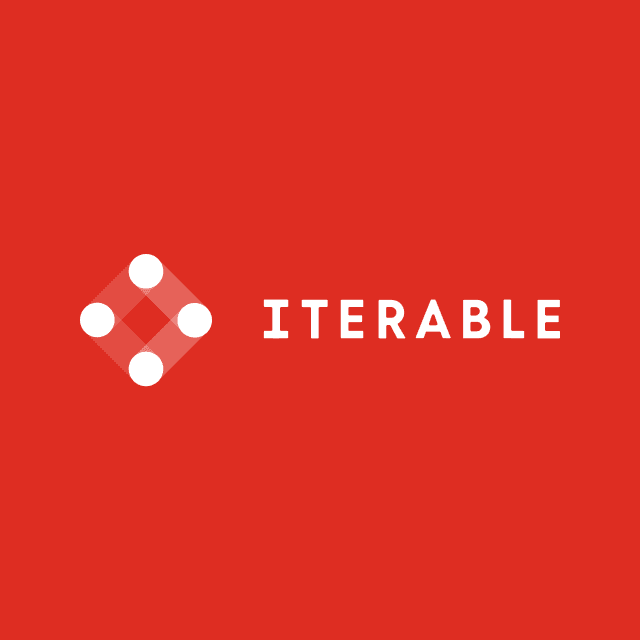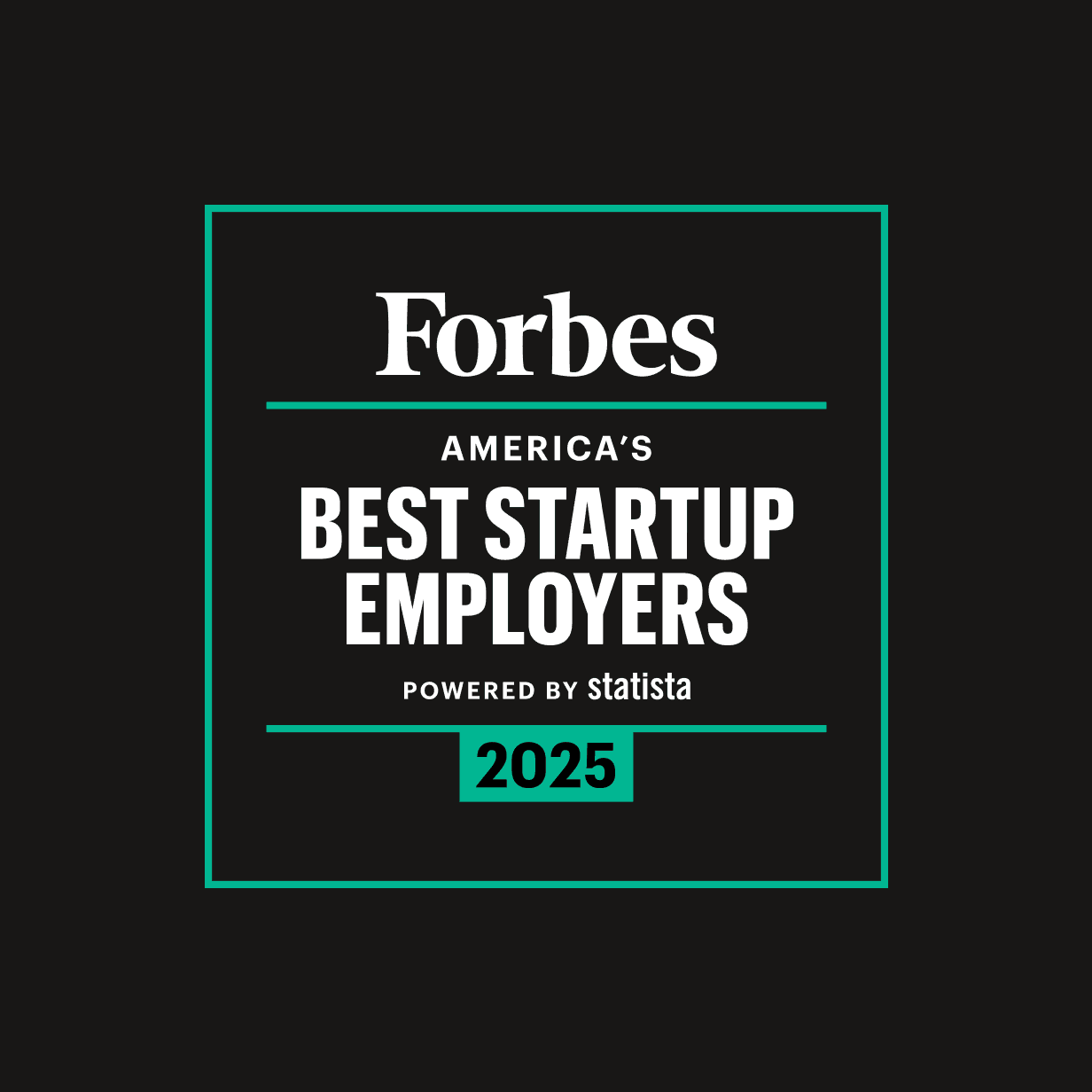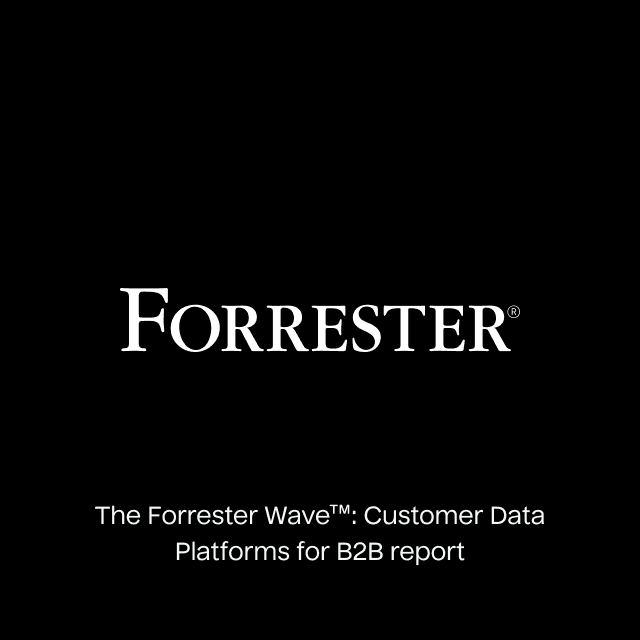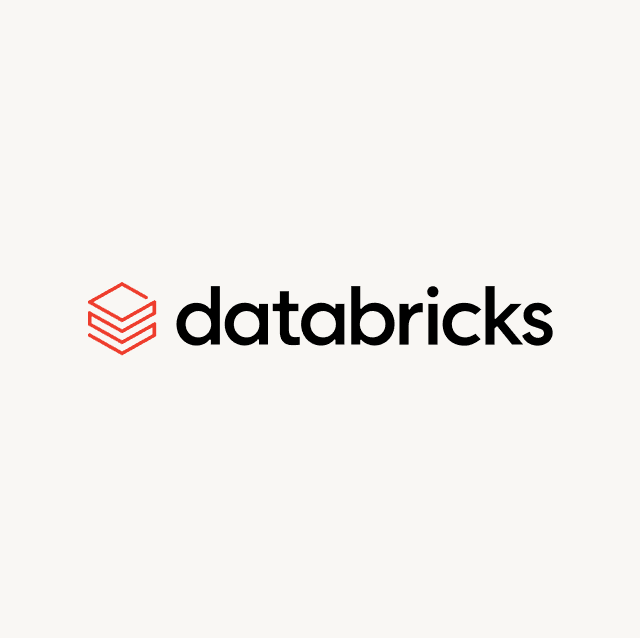When we first started this company, people called our product Reverse ETL. That’s because they thought Hightouch simply replicated data from the warehouse into different SaaS tools like Salesforce, which is reminiscent of ETL but just the reverse. Over time, those very same customers came back and kept finding new use cases for the Hightouch product, and our team kept executing to fill those needs, with new product features and frameworks behind the scenes. Fast forward a year and a half, and we’ve outgrown Reverse ETL because Hightouch is more than that: Hightouch is a Data Activation Platform.
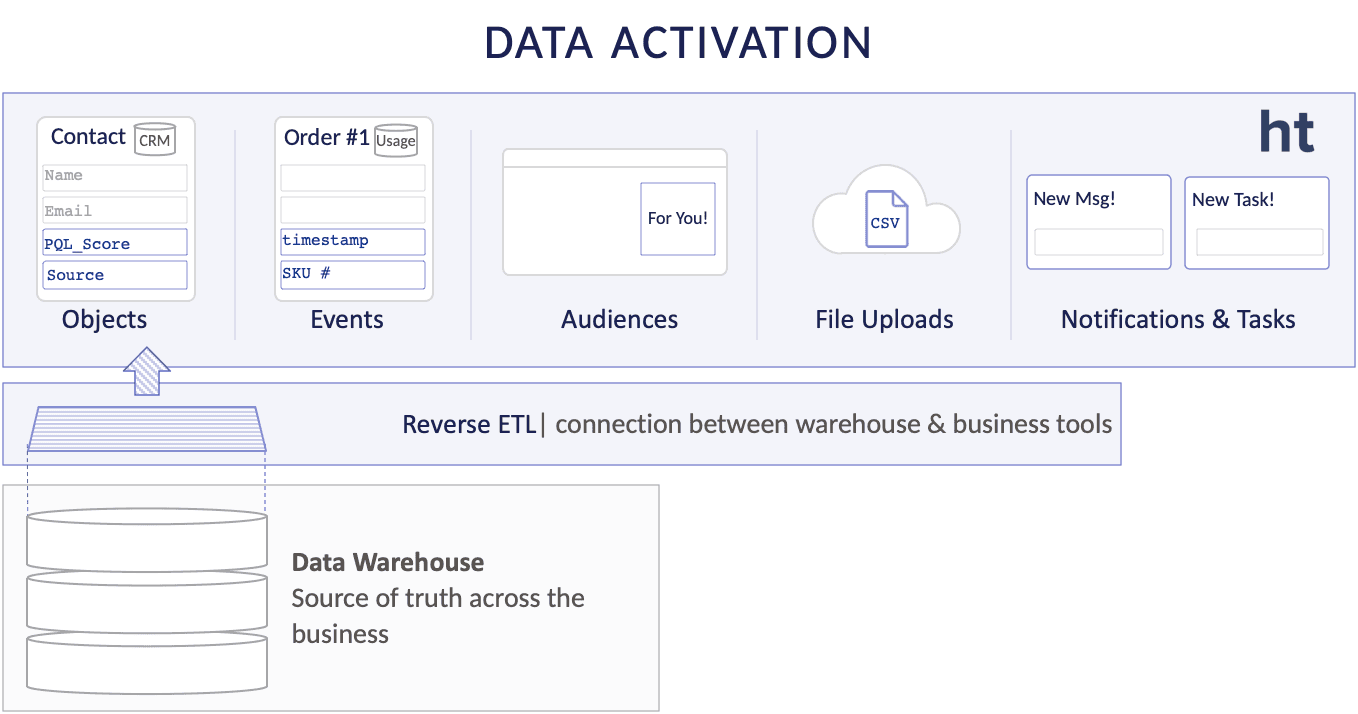
What is Data Activation?
We first introduced Data Activation in our post, Data Activation: The Next Step after Analytics, and we believe Data Activation is the next step in the modern data stack. Instead of simply analyzing data to make data-informed decisions, data activation shifts the focus from understanding data to taking action on data.
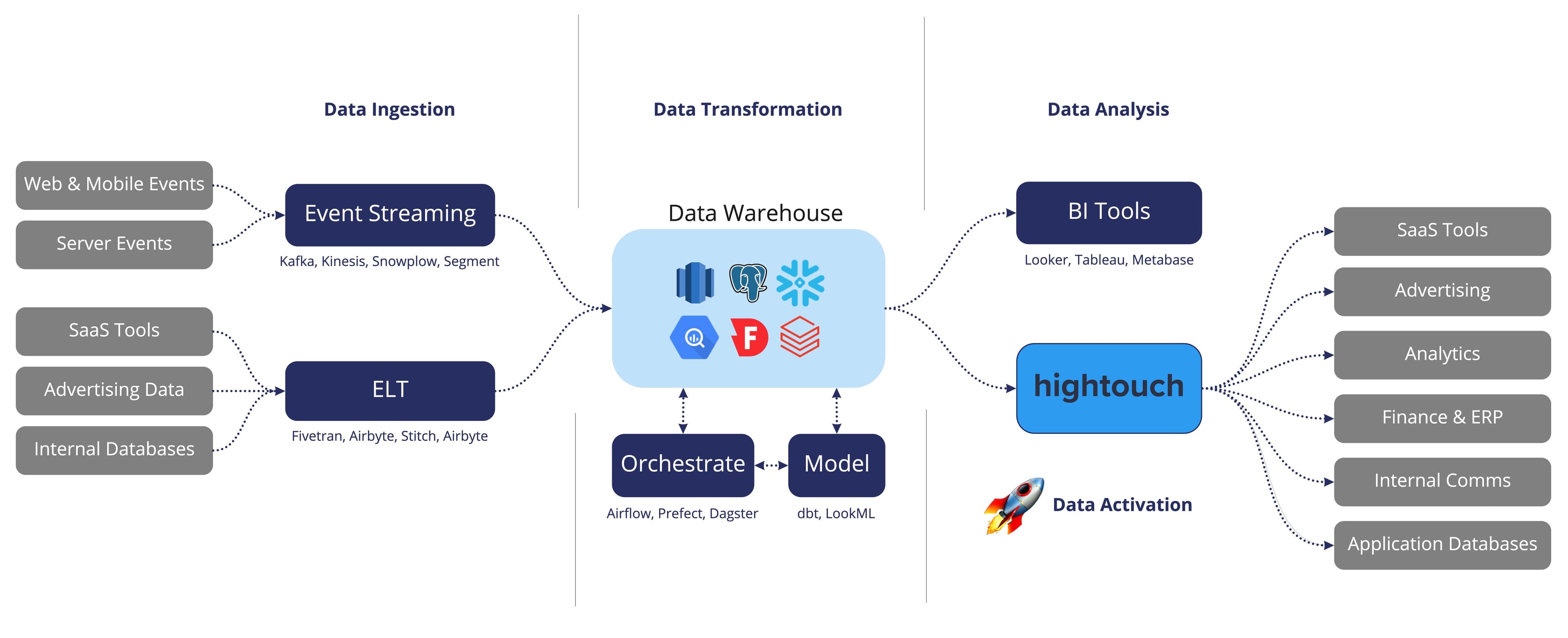
What does this actually look like for teams in a real workplace? It means business users can see customer data at the right time, take action on it, and build automations to streamline critical processes.
A core problem with data warehouses is that data is only accessible to technical users who know how to write SQL. This barrier to entry is problematic because business teams like sales, marketing, support, success, finance, etc. need access to the customer data but can’t get it.
Currently, companies accomplish Data Activation by writing against 3rd party APIs via in-house scripts. The complexities are outlined in this post by Pedram Navid, and you’ll see how Hightouch makes this significantly easier for end-users through a SaaS product.
The unique data models that live in your data warehouse (ex: items in cart, lead score, recent signups, session length, messages sent, workspaces created, subscription type, ARR, LTV, etc.) can all be made available to business teams via Data Activation and Hightouch. And because Hightouch activates data from a central source of truth, it ensures the correct and consistent definitions maintained by data teams are shared with business teams.
How We Outgrew Reverse ETL
The name “Reverse ETL” makes people think of data replication or copying/pasting data from one database to another. In the Hightouch case, an example would be copying the Users table in Snowflake to the Contacts object in Salesforce. The key is that this operation is relatively simple: users → users data syncing. And it’s true that most Hightouch customers start with simple use cases like these.
Originally we called ourselves Reverse ETL because our customers called us Reverse Fivetran, and for no reason other than that. Then, as we grew Hightouch, we built several new frameworks that expand past the concept of table → table data replication, which we describe in detail in the next section below.
What about Operational Analytics? It’s just another name for Data Activation. Though we find Data Activation to be more aligned with our product and clearer to end-users: activate data from places you already have it stored, and make it available in places where you can take action.
Our users have told us time and time again that they don’t understand what Operational Analytics means. They get confused because Operational Analytics sounds like analytics that someone does about their company’s operations.
We want data teams to live front and center in their organizations, and be known for directly driving and impacting business metrics and empowering other teams with data. For that reason, Data Activation is more in-line with our vision.
The Shift to Data Activation
Traditional Reverse ETL where columns are mapped from a source table to a destination table only informs one of our five destination syncing frameworks at Hightouch. We have a specific name for this framework at Hightouch called the Object Relational Mapping (ORM) framework. The ORM framework always syncs data from one table to another table, and users always map columns from the left side to the right side. Even though we would claim similar tech powers all five frameworks, users think of table-to-table column mappings when they think of Reverse ETL.
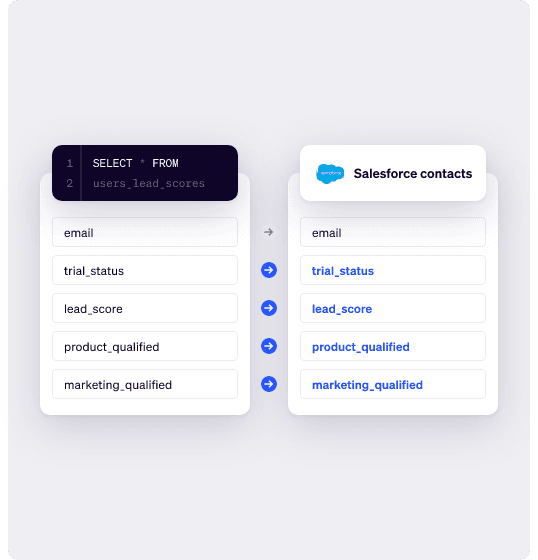
Hightouch would be limited if it only supported ORM-type syncs. Instead, users can choose from Hightouch's five different frameworks for destination syncs: ORM, events, notifications, audience syncing, and file uploads.

For example: If a manager wanted to create tickets in Zendesk every time a billing error was encountered, and Hightouch only supported data replication, they would need a Zendesk tickets table in their warehouse to replicate to Zendesk. Hightouch does not require this. Instead, the manager can query all users that encountered the billing bug, and create tickets linked to the respective Zendesk Organization automatically once those users cross a certain threshold.
Each of those five frameworks has different operations under the hood that users do not have to worry about, but would not be able to live without. It’s a big UX improvement, and also an important big functional improvement. By no means are our frameworks comprehensive, and we will likely build more!
The Six Data Activation Frameworks at Hightouch
Over time, as we built new features and frameworks for moving data, our product itself began to diverge from the definition of Reverse ETL. We began to see customers create Slack bots with Hightouch, automatically assign tasks in Salesforce, and automatically generate invoices in Netsuite.
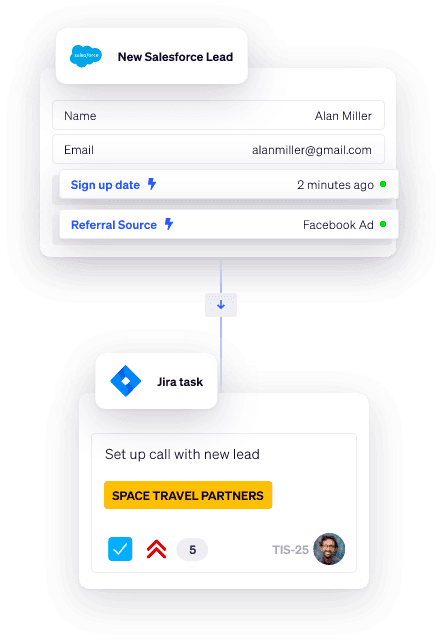
As we saw more of these use cases, we began to enumerate ways in which the Hightouch product does a lot, a lot more than Reverse ETL. Eventually, we built the six frameworks that became Data Activation:
Objects:
- Description: syncing data from one table to another table, and mapping columns from the source model to the destination
- Common destinations: Sales CRMs (Salesforce, Hubspot), Marketing CRMs (Braze, Iterable), Intercom, ERPs & finance tools (Netsuite and Anaplan), and 70+ more. This also includes database destinations like Postgres and --- MongoDB (for in-app personalization).
- Example Use Case: Sync product engagement data from the warehouse into Salesforce. Sales needs to see how much a customer has consumed and which features they’ve interacted with so that they can sell the right features and limits.
Event syncing:
- Description: syncing event data into destinations that allow analysis or action on events. The user selects the object on which the events are performed. Hightouch will store the timestamp of the latest event during each sync so that only newer data is pulled from the database, which speeds these syncs up considerably.
- Common destinations: Amplitude, Mixpanel, Braze events, and Iterable events
- Example Use Case: Sync purchase event data to Braze so that marketers can automatically enroll buyers of specific products in relevant email campaigns, based on the color and category of the purchased product.
- Definition: send messages to internal team members or to customers directly, triggered by data in the warehouse
- Common destinations: Slack, Mattermost, and Microsoft Teams
- Example Use Case: Any time a customer workspace surpasses the limit of the free tier, send a message in Slack tagging the relevant salesperson and notifying them that they should reach out and ask the workspace to pay (PQLs).
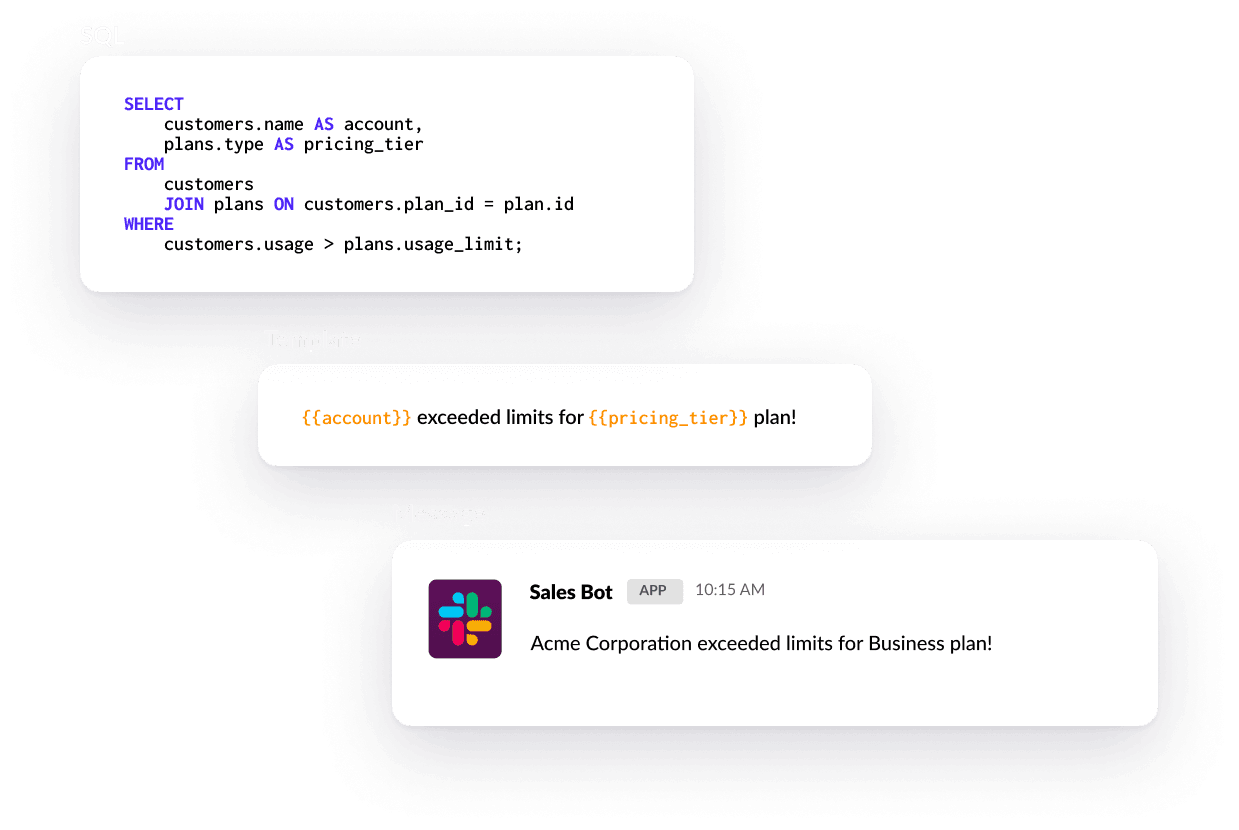
- Definition: Maintain a list of users in destinations that have audience lists. Both create users as they enter the audience, and delete users as they leave the audience.
- Common destinations: Facebook Audiences, Google Ads, Bing, Tik Tok, Snapchat, Mailchimp, Sendgrid, SFMC
- Example Use Case: When someone fills out a coupon form and enters their email address, upload their email to a Facebook, Google, and Tik Tok audience so that they receive ads about products they’re interested in. When they purchase a product, remove them from all three audiences.
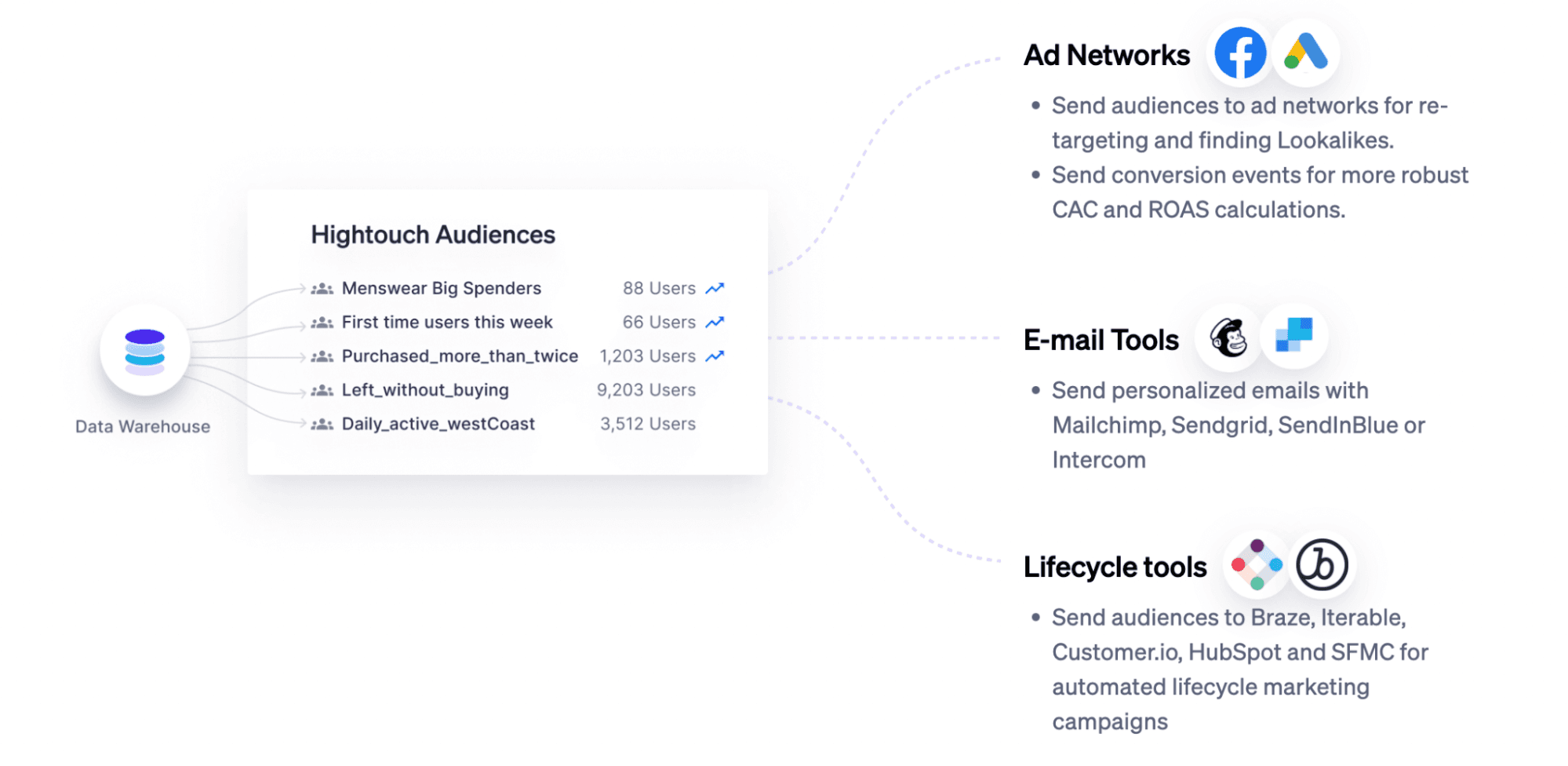
File Uploads:
- Definition: Download the results of a query as a file, and upload the file to an external storage bucket. That storage bucket could be internal-facing or client-facing.
- Common Destinations: SFTP, S3
- Example: Clients run ads on an advertising platform. The identities of clicking users are stored in the advertising platform’s data warehouse and shared with the clients via SFTP.
Tasks:
- Definition: Automatically create tickets or tasks based on rules defined by a SQL query or model. Only create that ticket or task once for each user, even if the action is performed twice. Currently, this framework fits under ORM, but it may be split out.
- Common Destinations: Asana, Jira, Zendesk, Salesforce
- Example Use Case: Query workspaces that just graduated from 4 users to 5 users (PQL). Automatically create a task in the helpdesk tool (Jira or Zendesk) so that a support rep can reach out to the workspace and ask if they need help setting up any premium features.
Each customer of Hightouch uses the product in a different way, and the majority eventually graduate to doing more than Reverse ETL:
- Vendr automates customer touchpoints
- Compare Club reduced cost per lead by 10%
- Retool increased email response rates by 32%.
- Circle CI activates dbt models to measure ROI
- Blend reduced reporting time by 50%
- Nando’s improves customer loyalty & reduces data integration time by 75%
Data Activation is Powered by Reverse ETL
Our team is still building Reverse ETL, but only for a subset of use cases, and the term is only meaningful to a select group of people. Today nearly every Hightouch customer is using the platform to power Data Activation, and that is what Hightouch will be known for.
Our Data Activation Platform is powered by our core technology, Reverse ETL. We will continue to use the term Reverse ETL to describe our technology as its core operation under the hood, but Data Activation embodies the complete scope of the variety of data problems we solve. Data Activation is why customers are jumping up and down about Hightouch, and we’re excited to embrace that!
Data Activation Will Require New Interfaces
Hightouch’s vision is to build different interfaces on the warehouse to accomplish different use cases for different personas. Over time, we want to be responsible for all Data Activation from the warehouse, regardless of whether that requires moving the data, caching it, or building interfaces on top of it directly. Different vertical use cases deserve new interfaces in our app, Hightouch Audiences being the first of those, but with many more to come.
If this work seems interesting to you, we are rapidly expanding our team! Please shoot us a note at hello@hightouch.com or check out our careers page here. And if you think Hightouch can be used at your company don’t hesitate to reach out or sign up for free!






